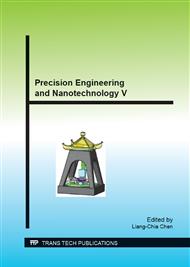p.346
p.355
p.360
p.366
p.372
p.378
p.384
p.392
p.398
High Efficiency Tool Path Generation for Freeform Surface Machining Based on NURBS Subdivision
Abstract:
Along with the rapid development of CAD/CAM system, the smooth surfaces are widely used in industry design. Especially NURBS surface attracts rising attentions because NURBS can describe flat surface, freeform surface and so on. Currently a lot of tool path generation patterns are proposed for milling process of freeform surface. Nevertheless there are still some problems on generating efficient tool path for freeform surface under the requested surface finish roughness. In this research, in order to resolve these problems, NURBS surface is divided into some patches and the tool path is generated on each patch. This paper proposes a surface divide method and makes a comparison between this method and undivided method. As a result, it is found that dividing the surface is helpful for the making shorter tool path and increase the machining efficiency.
Info:
Periodical:
Pages:
372-377
Citation:
Online since:
August 2014
Authors:
Price:
Сopyright:
© 2015 Trans Tech Publications Ltd. All Rights Reserved
Share:
Citation:


